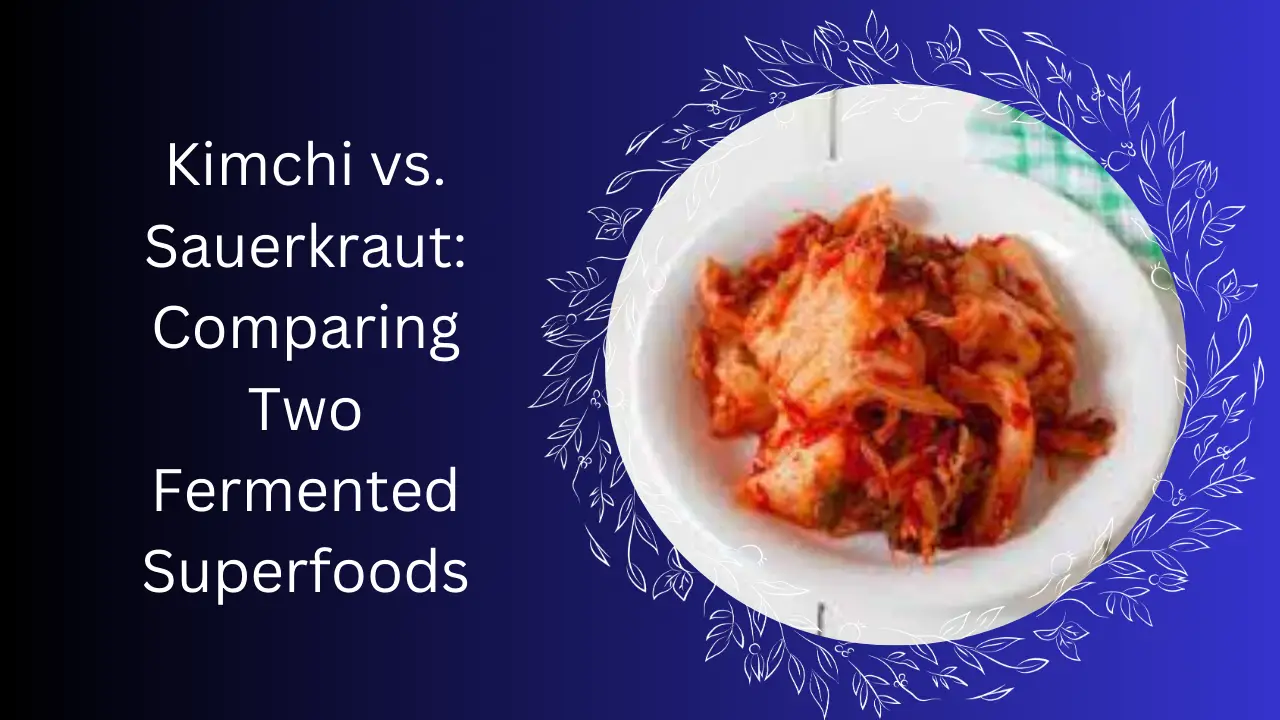
bussdis Under Cabinet Banana Hook Foldable - Adhesive Banana Hanger, Magnetic Banana Holder Hook Under Counter, Sticky Banana Hook, Metal, Black
$7.99 (as of October 22, 2024 10:19 GMT +00:00 - More infoProduct prices and availability are accurate as of the date/time indicated and are subject to change. Any price and availability information displayed on [relevant Amazon Site(s), as applicable] at the time of purchase will apply to the purchase of this product.)Kimchi vs. Sauerkraut: Comparing Two Fermented Superfoods
In the world of fermented foods, two standouts have garnered considerable attention: kimchi and sauerkraut. These pungent and tangy dishes have a lot in common but also some unique differences. In this article, we’ll delve into the world of kimchi and sauerkraut, exploring their origins, nutritional benefits, flavor profiles, and much more. By the end, you’ll have a better understanding of these fermented superfoods and which one might tickle your taste buds or benefit your health more.
What is Kimchi?
Kimchi is a beloved staple in Korean cuisine. It’s a spicy, fermented vegetable dish that can be made using various vegetables, most commonly Napa cabbage, radishes, and scallions. The key to kimchi’s unique flavor is its blend of ingredients like garlic, ginger, chili pepper flakes, and fish sauce, all mixed together and left to ferment.
What is Sauerkraut?
Sauerkraut, on the other hand, hails from Germany and is essentially fermented cabbage. To make sauerkraut, cabbage is thinly sliced and fermented with salt. The result is a tangy and crunchy condiment that pairs wonderfully with sausages and other hearty German dishes.
Origins and History
Kimchi has a history dating back over 2,000 years in Korea and has evolved over time. It was initially a way to preserve vegetables during harsh winters. Sauerkraut has a shorter history, originating in Europe during the Roman era. It was primarily used as a source of sustenance for long journeys, given its excellent shelf life.
Nutritional Value
Both kimchi and sauerkraut offer a plethora of vitamins and minerals. They are low in calories and provide essential nutrients like vitamin C, K, and fiber. Kimchi, owing to its diverse ingredients, also contains more vitamins and antioxidants.
Health Benefits
The health benefits of these fermented foods are remarkable. They are rich in probiotics, which promote a healthy gut microbiome. These probiotics contribute to better digestion and a stronger immune system. Additionally, some studies suggest that fermented foods may help with weight management and reducing inflammation.
Flavor Profiles
The flavor profiles of kimchi and sauerkraut couldn’t be more different. Kimchi is spicy, pungent, and bursting with umami, thanks to ingredients like fish sauce and umami-rich vegetables. Sauerkraut, on the other hand, offers a satisfying tanginess with a mild cabbage undertone.
Fermentation Process
The fermentation process for both dishes involves the action of lactic acid bacteria. However, the flavor and texture differences arise from variations in ingredients and fermentation times. Kimchi ferments faster, typically within a few days to weeks, while sauerkraut can take several weeks to develop its full flavor.
Probiotics and Gut Health
Probiotics are the stars of the show when it comes to these fermented foods. The live bacteria in kimchi and sauerkraut are known to support digestive health by maintaining a balanced gut microbiome. They can aid in alleviating digestive issues such as bloating and irregular bowel movements.
Culinary Uses
Kimchi and sauerkraut are incredibly versatile in the kitchen. Kimchi adds a kick to dishes like fried rice, noodle soups, and even sandwiches. Sauerkraut is a classic topping for hot dogs and a great addition to salads and Reuben sandwiches.
Cultural Significance
Kimchi holds a special place in Korean culture and is often considered a symbol of Korean identity. It’s an integral part of many Korean celebrations and rituals. Sauerkraut, while not as deeply intertwined with German culture, is still a beloved side dish at Oktoberfest celebrations.
Making Kimchi at Home
If you’re feeling adventurous, making kimchi at home is a rewarding experience. It allows you to customize the spice level and ingredients to suit your taste.
Making Sauerkraut at Home
Sauerkraut is one of the simplest fermented foods to make at home. With just cabbage, salt, and a little patience, you can have your homemade sauerkraut in no time.
Kimchi vs. Sauerkraut: Taste Test
Let’s settle the debate – which one tastes better? We’ll conduct a taste test to help you decide based on your palate preferences.
Which One Is Healthier?
For health-conscious readers, we’ll delve deeper into the nutritional aspects and probiotic content to determine which of these fermented foods might offer more significant health benefits.
Conclusion
In the clash of cultures and flavors, kimchi and sauerkraut both emerge as winners. They offer distinct tastes and health benefits, making them valuable additions to any diet. Whether you prefer the fiery kick of kimchi or the milder tang of sauerkraut, both of these fermented superfoods have something unique to offer your taste buds and your well-being.
FAQs
1. Can I eat kimchi or sauerkraut if I’m lactose intolerant?
- Yes, both kimchi and sauerkraut are lactose-free as they are made through lacto-fermentation, which breaks down lactose.
2. Are there any variations of kimchi and sauerkraut I should try?
- Absolutely! There are countless regional and ingredient variations for both kimchi and sauerkraut. Exploring these can be a delightful culinary adventure.
3. Can I eat kimchi or sauerkraut every day for its health benefits?
- While they are nutritious, moderation is key. Eating them in excess may lead to digestive discomfort for some individuals.
4. Are there vegan versions of kimchi and sauerkraut available?
- Yes, you can find vegan versions that omit ingredients like fish sauce. These are suitable for a plant-based diet.
5. Can children enjoy kimchi or sauerkraut?
- Yes, in moderation. Start with small amounts to see if they enjoy the flavors, as they can be quite bold for young palates.











